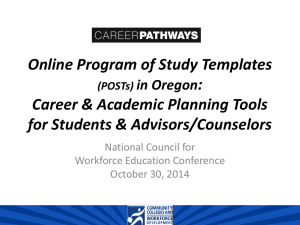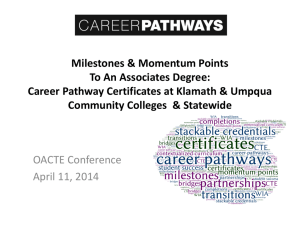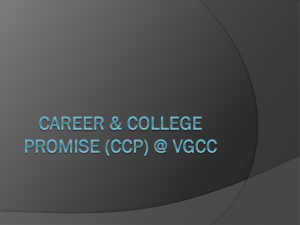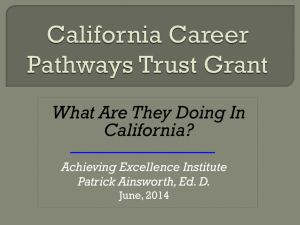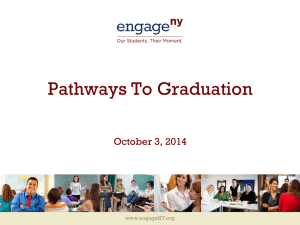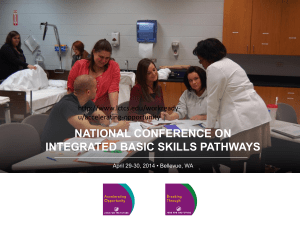Mimi Maduro - National Council for Workforce Education
advertisement
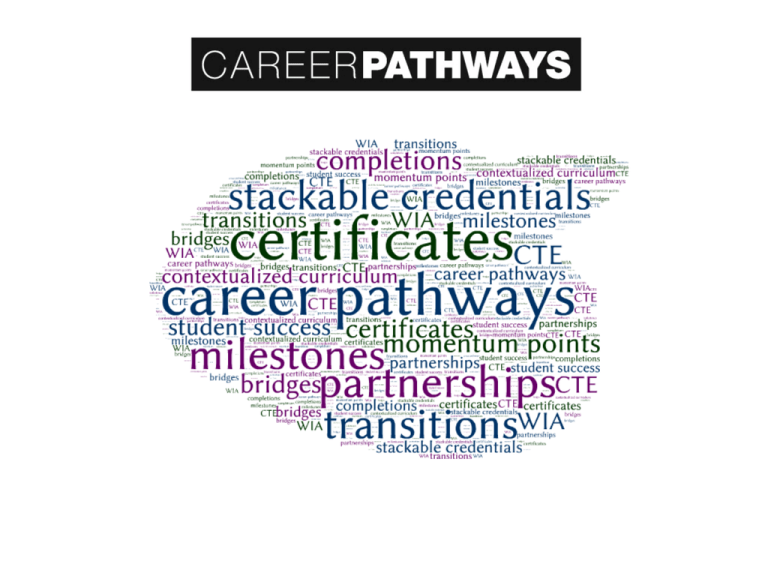
Oregon’s Guiding Vision • In service of meeting Oregon’s 40-40-20 Education Goal for the “middle 40” by 2025 • Certificate completion & continued education • Address the changing needs of employers, job seekers, workers, and students • Focus on Career & Technical Education (CTE) short-term certificates tied to occupations Goals • To increase the number of Oregonians with certificates, credentials, and degrees • To ease transitions across the education continuum—high school to community college; pre-college (ABE/GED/ESL) to postsecondary credit ; community college to university; and to employment What’s a Career Pathway? Career Pathways are linked education and training services that enable students, often while they are working, to advance over time to successfully high education and employment in a given industry or occupational sector. Each step of a Career is designed to prepare students to prepare student stop progress to the next level of employment and education. What’s a Career Pathway? (continued) Career Pathways focus on easing and facilitating student transition--- from high school to community college; - from pre-college courses (ABE/GED/ESL) to credit postsecondary; - from community college to university or employment. Oregon’s Student Success Plan • Career Pathways is included in the Oregon Community College Student Success Plan as a “best practice” • Career Pathways & Less Than One Year Certificates are “milestones” and “momentum points” to an associate degree • Completion of these short-term certificates is student success indicators and key performance measures for CCWD Leadership • Oregon Presidents’ Council Career Pathways Resolutions 2006, 2008, 2010, 2012 • State Board of Education • Oregon Workforce Investment Board Strategic Plan • Worksystems, Inc. (Portland WIB—significant seed funding early years) • Oregon Pathways Alliance: collaboration of leaders from 17 colleges meeting quarterly since 2004 • CCWD statewide coordination role Scaling • Launched with five colleges in 2004 with initial funding from the Governor’s Workforce Investment Fund through the OWIB • Expanded to 11 colleges in 2006 • Scaled to all 17 colleges in 2007 Capacity Building & Professional Development • Oregon Pathways Academies 2005 & 2007 with team from each college w/ partners • Oregon Healthcare Career Pathways Summit 2008; 17 college team plus employers • Training and technical assistance provided statewide ongoing basis • Quarterly Alliance meetings focused on peer learning and migrating promising practices Leveraged/Braided Funding • • • • • Governor’s Employer Workforce Fund WIA Incentive (awarded 4 consecutive years) WIA Title I-B Perkins Community College Strategic Fund (CCSF) Career Pathway Grants • Career Pathway Grants provided to colleges each biennium to build capacity and increase number of completions • Grants awarded on competitive basis 2004-2006 • For past three bienniums grants awarded to all 17 colleges (2007-09, 2009-11, 2011-13) • Grants focus on goals & strategies to build capacity & increase completion outcomes • Funding: WIA Title I-B, WIA Incentive Grants, Governor’s EWTF, Perkins, CC Strategic Fund Oregon Pathways for Adult Basic Skills • Five “bridge” courses for “pre-college” ABE/GED/ESL students contextualized to reading, writing, and math. • Includes a “College & Career Awareness” course • Non-credit • Major goal of grants: Increasing transition of ABS student to CTE certificate programs/credit postsecondary Career Pathways Systemic Approach: Institutional Self-Assessment Dimensions • • • • • • • • • Leadership Leveraged Resources Certificates & Roadmaps Articulation with high schools & universities Pathways for Adult Basic Skills students Student Services and supports Connection with Workforce partners Employer Engagement Using data for continuous improvement Career Pathway Roadmap Webtool • Alliance collaborated to design Career Pathways Roadmap Webtool • More than 350 roadmaps and high school to community college plans of study online • Lane CC hosts server and training/technical assistance funded by CCWD; Effie Siverts • http://oregon.ctepathways.org (guest login) • Open Source • Adopted by state of Washington Career Pathway Marketing & Communications • • • • • • • 30 second TV/radio spot statewide -6 months Here’s link: http://www2.clackamas.edu/pathways/ 90 second video by Lane Community College: Here’s link: http://lanecc.edu/pathways MyPathCareers brochure & Roadmaps “card” Stackable Credentials • Career & Technical Education (CTE) • Occupations in six career focus areas • Short-term certificates (12-44 credits): – Career Pathway Certificates (CPCC) – Less Than One Year Certificate (LTOY) • Examples of stackable credentials for Lower Divison Transfer: Oregon Transfer Module (OTM) & Associate of Arts Oregon Transfer (AAOT) Policy Direction Drives Increased Completions • State Board of Education approved Career Pathway Certificate (CPCC) effective July 1, 2007. • CTE program Certificates tied to competencies for jobs in local labor market & approved by employers • More than 250 Career Pathway Certificates offered statewide (12-44 credits) • More than 100 Less Than One Year (LTOY) Certificates offered already offered statewide (12-44 credits) • Average number of credits for certificates: 22 • More than 5,000 certificates have been awarded since 2008 • Pathways Descriptive Study of initial cohort of completers released March 2013 Financial Guidelines Federal and state financial aid is not designed for short-term Certificate programs and does not fund most Career Pathway, Less Than One Year (LTOY), and other stand-alone 12-44 credit Certificate Programs. Career Pathway, LTOY, and other stand-alone Certificates that are 36-44 credits and three terms in length can be submitted on a college’s Program Participation Agreement (PPA) and considered for federal and state financial aid. This guideline is similar for Apprenticeship Certificates. While many students are not entirely certain of their major goal when they enter community college and apply for financial aid, declaring an associate degree as their major goal allows students the most options to attain a certificate or degree. Students who declare a course of study as an Associate Degree can obtain a Career Pathway Certificate, LTOY, or other stand-alone Certificate as they complete the required coursework toward attaining their degree goal. Career Pathway Certificates & Less Than One Year Certificates are “momentum points” in student progression toward an associate degree. CLASP Alliance for Quality Career Pathways • Field testing using Pathways Descriptive Study data for 08/09 & 09/10 completer cohort • Career Pathways & AQCP framework aligned with Governor’s Sector Strategy • Reviewers include: Oregon Pathways Alliance, Governor’s Workforce Policy Advisor, Advancing CTE in Career Pathways (OVAE initiative), CTE Leaders statewide • Framework will inform colleges’ Sustainability Plans (due June 2014) For More Information… Mimi Maduro Pathways Initiative Statewide Director Oregon Department of Community Colleges & Workforce Development (CCWD) 541-506-6105 mmaduro@cgcc.edu
